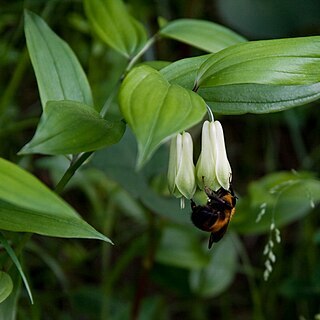Glabrous rhizomatous herbs. Aerial stems annual, erect, branched. Leaves cauline; the lower brown and scale-like with a sheathing base; the others alternate becoming opposite distally, flat, with many veins, petioled, usually ovate, obtuse at base. Peduncles terminating vegetative branches, not articulated, bearing 1-6 nutant flowers in an umbel. Perianth segments free, equal or subequal, erect or distally recurved, several-veined, usually saccate or spurred at the base. Filaments linear to lanceolate, attached to the receptacle or the base of the perianth; anthers dorsifixed, linear-oblong, extrorse. Ovary superior, sessile, ovoid to obovoid, 3-celled; ovules axile, 2 per cell; style filiform, with 3 recurved stigmatic branches. Fruit a 1-3-seeded berry.
Fls perfect; tep 6, elongate, similar, distinct; stamens 6, inserted on the base of the perianth; filaments elongate; anthers linear-oblong, extrorse; ovules 2–6 per locule; style with 3 short, spreading stigmas, or undivided; fr a trilocular, ellipsoid to obpyriform, few-seeded berry; rhizomatous herbs, the stem forked above and bearing several sessile, reticulate-veiny lvs; fls rotate or campanulate, drooping or spreading, solitary or in small umbel-like clusters of 2 or 3 terminating the branches. 15, Asia and N. Amer. (Prosartes, the 5 N. Amer. spp., perhaps to be held as distinct)

